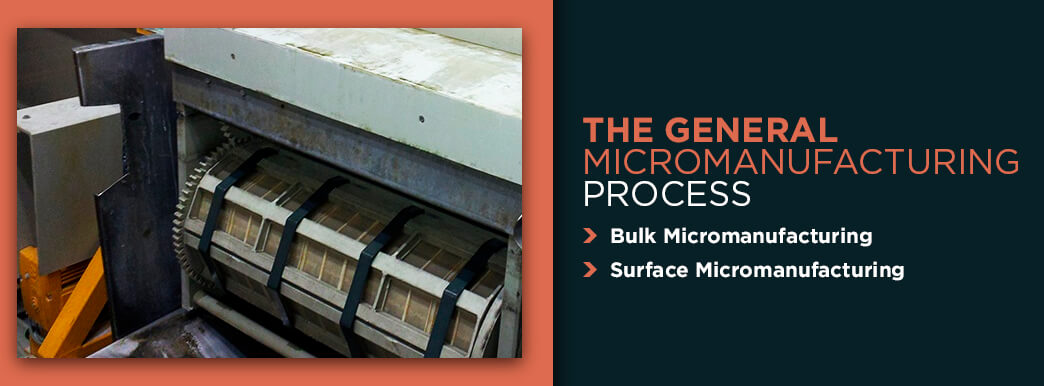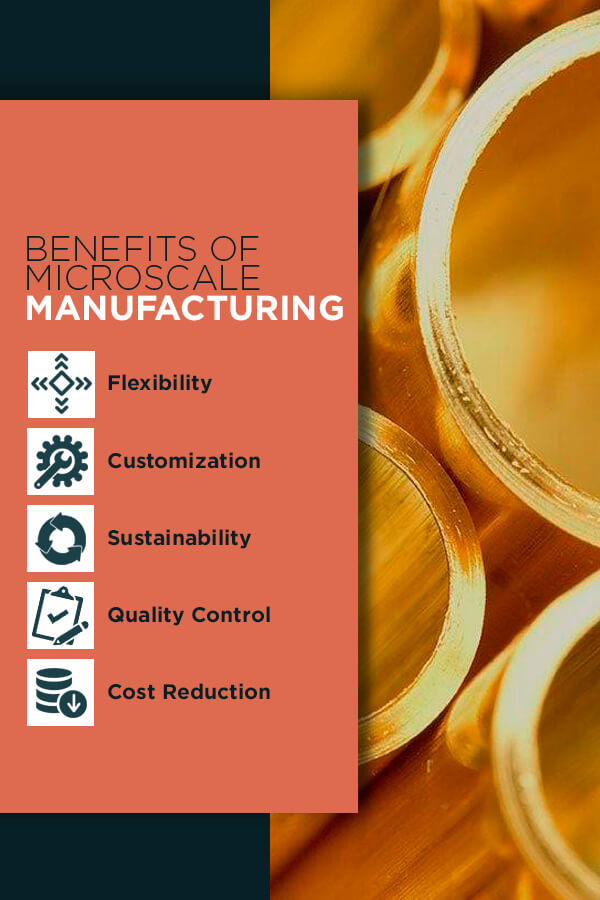Micro is the way of the modern world — from consumer products to the medical and aerospace industries, getting the most output with as little input as possible is the goal for many manufacturing operations. Enterprises are using smaller, more precise components, and manufacturing methods must adapt to produce these components accurately and cost-effectively. While traditional methods may not work on such scales, especially with precious metals and difficult substrates, micromanufacturing methods can be successful. By producing small products on a small scale with a focus on quality, companies can maximize their materials and remain competitive in the increasingly micro world.
Quick Links
What is Micromanufacturing? | The Micromanufactuing Process |
Types of Micromanufacturing Processes | Benefits of Micromanufacturing Processes |
Benefits of Microscale Manufacturing | The Future of Micromanufacturing and Electroplating |
Get Micromanufacturing Services From SPC |
What Is Micromanufacturing?
There’s often some confusion as to what micromanufacturing means — this is because the term has two definitions. Micromanufacturing can refer to manufacturing a small number of parts, or manufacturing parts at a small size.
Micromanufacturing is a process to produce at small sizes is used to create extremely fine substrate surfaces. These types of methods create electronic and mechanical elements using a variety of innovative microfabrication technologies, enabling the creation of microscopic devices. Typically, to be considered a micro-part, the final product needs to be under 10 millimeters in size, with tolerances within the range of 0.1 to 10 micrometers. Micro-parts are usually produced on a silicon wafer, though this largely depends on the individual part and the processes used to produce it.
On the other hand, micromanufacturing in reference to small-scale manufacturing is a practice where facilities produce at limited quantities. These small-batch manufacturing operations are becoming increasingly practical with the progressively decreasing prices of manufacturing tools, and many companies are choosing micromanufacturing practices to keep quality high and costs low.
While these two definitions seem at odds, they both contribute to a single end goal — to produce high-quality products to meet the needs of consumers. We’ll discuss both in detail to help you understand how each can help with your next project.
The General Micromanufacturing Process
Micromanufacturing production processes differ based on the product in question, but typically use one of two methods — bulk micromanufacturing or surface micromanufacturing.
1. Bulk Micromanufacturing
Bulk micromanufacturing is a subtractive manufacturing process involving the creation of three-dimensional components and structures inside a substrate. This is accomplished by etching a silicon wafer using dry or wet etching techniques — wet etching uses chemical solvents to achieve this while dry etching uses plasma to remove material from the desired area. A mask is added to the surface of the wafer through photolithography to prevent areas of the wafer from being etched, then the etching chemical removes material from the unprotected sectors, creating angled pits. The primary benefit of this method of production is that it is very inexpensive, and its best suited to creating microstructures with simple geometry.
2. Surface Micromanufacturing
Surface micromanufacturing, on the other hand, is an additive process that occurs on top of the substrate. This is usually accomplished by depositing a series of masks and coatings, each modified through etching. In general surface micromachining processes, a sacrificial layer is added first, sculpted using etching, then a functional layer is added on top of that and the sacrificial layer is removed, creating voids necessary for the functionality of the surface part. While more expensive, this process results in less substrate loss and enables the development of smaller, more uniform pieces.
Types of Micromanufacturing Processes
Bulk micromanufacturing and surface micromanufacturing are the two most common micromanufacturing processes, but there are several other types of micromanufacturing processes and methods, each of which elicits specific results. These types of micromanufacturing are listed and explained in more detail below:
1. Molding
Molding is a process used on a variety of materials, including plastic, glass and metal, to mold the substrate into a base shape. This staple of manufacturing is commonly seen in plastic injection molding, where a plastic substrate is injected into a mold, where it sets and creates a solid object. Micromolding takes this concept and translates it to a smaller scale, allowing for the creation of complex objects a fraction of a millimeter in size or thickness. These smaller sizes allow less room for error and enable designers to use more difficult materials like thermoplastic resins. Micromolding is used across a broad range of industries but is most commonly seen in the electronics and medical industries.
2. Welding
Traditional gas tungsten arc welding involves applying electric bursts to workpieces, creating the heat needed to melt and add to the material. Micro welding uses this same concept on a smaller scale, using lower amperages to achieve similar results at a much more precise level — in fact, micro welding using lasers is becoming increasingly more common and desirable. Also known as precision welding, micro welding uses very thin materials and tight tolerances, often with weld requirements below one micron. This is also a process that can easily be automated, allowing for incredible precision and consistency. Micro welding is often used in the production of electronic components but is also used to produce medical implants and aerospace components.
3. Machining
CNC machining is commonly used throughout the manufacturing industry to produce complex geometries at a macro scale. However, this same process can be translated to a microscale, following tight tolerances to create these complex shapes in plastic or metal at a micro size. Machining generally includes any mechanical cutting processes, including milling, turning and grinding, and at the microscale, this requires specialized CNC tools. This procedure is often used in the production of medical and aerospace components, especially complex components.
4. Additive
Additive processes include anything that adds more material to a substrate. Deposition is one of the most common additive processes in manufacturing and is highly useful in micromanufacturing. Laser metal deposition is particularly popular, melting metallic powder to the substrate to create a strongly-bonded coating with controlled dimensions. This method can be used to stack layers to alter the shape and functionality of the part. Because this method requires low energy input, doesn’t need cutting fluid and doesn’t produce dust, it is very quick, highly efficient and results in minimal deformation.
This only scratches the surface of current and future micromanufacturing techniques, but these are the most popular. Also popular is the combination of two or more micromanufacturing processes, which is called a hybrid process.
Benefits of Micromanufacturing Processes
Micromanufacturing processes meet the demands of today’s customers and deliver unique advantages for a variety of industries. Some of the benefits of using micromanufacturing methods include:
- Material flexibility: Micromanufacturing enables designers to use certain types of materials that are difficult, if not impossible, to use at meso- and macro- sizes. Certain materials and alloys cannot withstand external stresses from traditional manufacturing processes but can handle micromachining processes.
- Tight tolerances: Micromanufacturing can work within incredibly tight tolerances — such processes can produce parts with feature sizes of less than 100 micrometers, which is only slightly thicker than a human hair, which has a diameter of 60 to 80 micrometers. This ability to work at small sizes with extremely tight tolerances allows manufacturers to maintain a high level of precision throughout their operations. This allows for consistently high quality and means that parts are produced correctly, which is essential for medical and aerospace applications where accuracy is paramount.
- Speed and cost: Any type of manufacturing must take time to produce a quality product, but small-size products generally take less time to produce. This means faster turnaround times, lower costs and more satisfied customers.
As micromanufacturing processes continue to develop and advance, these benefits will continue to grow. Companies will see an even greater return on investment by employing micromanufacturing techniques as the years go on, especially as the world turns increasingly toward microtechnology.
Benefits of Microscale Manufacturing
This brings us to manufacturing at a microscale. Though this is patently different from micromanufacturing processes, micromanufacturing practices are another important trend in the fabrication world. Micromanufacturing concepts center around the idea that small operations can achieve high throughput with limited space and resources, and that doing so can deliver numerous benefits to both the manufacturer and the consumer. Some of the most notable benefits of the micromanufacturing concept include:
1. Flexibility
Small scale operations are much easier to adjust than larger-scale operations, with manufacturers having greater control and supervision over all of the processes involved. This means that adjustments can be made quickly if the product isn’t turning out as desired, or if a design flaw comes up. Additionally, small scale operations can be repeated to meet the needs of the customer — if more orders than expected come in or if the designer wants to run a new batch, this can be done easily by simply repeating the manufacturing process. Small scale operations can also be transitioned to large-scale operations with relative ease, allowing for prototype or beta runs to transition into full-scale production later on.
2. Customization
If a product requires customization, it doesn’t make sense to use a massive factory setup — instead, small scale manufacturing operations can produce these parts. Whether custom parts are made individually or in small batches, a micromanufacturing setup can produce these items with great attention to detail. Such capabilities are particularly important for prototyping and custom-made products.
3. Sustainability
Smaller machines and smaller factories are more sustainable in general — these operations typically produce fewer pollutants and byproducts that could have a negative environmental impact. They also require less energy to operate — one study out of Japan found that reducing the size of a factory operation by 90% reduced total energy consumption by 99%. Additionally, small-scale production lines can be reused for a wide variety of projects, allowing a single setup to produce a multitude of designs without the need for brand new equipment.
4. Quality Control
Small manufacturers can keep a close eye on their product, ensuring that the parts they produce meet their standards — in fact, many small manufacturers maintain extremely high-quality control standards to minimize manufacturing defects. This ability to manage quality doesn’t just result in a better product — it also helps keep wasted material costs to a minimum.
5. Cost Reduction
The equipment needed for manufacturing operations is becoming smaller and cheaper, and this trend will continue as more people purchase or lease manufacturing equipment for personal use. This means that smaller operations are easier to establish. On top of this, micromanufacturing operations tend to have very low manufacturing costs — they use fewer materials, consume less energy, produce less waste and require little overhead since they require little space, few employees and minimal storage.
Micromanufacturing for small scale production is gaining in popularity for these benefits, but it’s also gaining traction due to the changes occuring in manufacturing industry as a whole — overseas manufacturing is becoming less popular and required turnaround times are getting shorter, so many manufacturers are turning to U.S.-based companies that they can trust to deliver the product on time.
The Future of Micromanufacturing and Electroplating
Micro is becoming the big trend in manufacturing, both in size and in scale. As of 2015, there are over 270,000 small manufacturers in the United States, most of which employ fewer than 50 employees, and these manufacturers can compete in the market mostly because of their customization capabilities and quick turnaround times. Simultaneously, small-size manufacturing is becoming increasingly necessary in the production of medical equipment and consumer electronics. Many expect the micromanufacturing industry to grow on both fronts.
In terms of micromanufacturing operations, small-scale manufacturers are easily keeping up with competitors. Despite not producing the same products as larger manufacturers, small manufacturers keep costs to a minimum by minimizing waste, maximizing quality control and avoiding overproduction. As time goes on, many more small-scale manufacturers are expected to enter the industry, especially specialized manufacturers for the medical industry and other markets. We may also see larger manufacturers choosing to employ small-scale techniques or establish specialty micromanufacturing locations.
As for micromanufacturing products, there’s still plenty of room to grow and techniques to perfect. Researchers are currently exploring the possibilities of hybrid processes using new technologies and specialty lasers, and potential automation applications are also being considered. As microtechnology continues to advance and demand for products using this technology increases, micromanufacturing techniques will continue to evolve and improve.
At the intersection of these two concepts is the idea of using small-scale operations to produce microtechnology. When combined with micromanufacturing processes, micromanufacturing operations can produce incredibly tiny products at a small scale, resulting in high-quality, low-cost results. If you’re interested in this possibility, or any of the possibilities involved with either type of micromanufacturing, SPC can help you get started.
Get Micromanufacturing Services From SPC
SPC offers effective micromanufacturing services that you can employ on your next project. Make use of our production team to produce a small number of the high-quality parts that you need, or use our micromanufacturing processes to produce small-size parts with incredible tolerances and professional attention to detail. SPC is a leading metal finishing company with over 90 years of history in the business, and you can count on us to help you enhance your production capabilities while lowering your costs.
Contact us to learn more about our micromanufacturing capabilities and how they can benefit your business. If you want to get started, you can also get a no-obligation price quote for any of our services.








